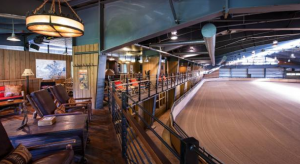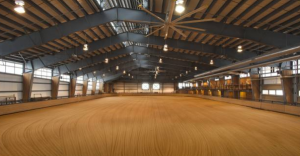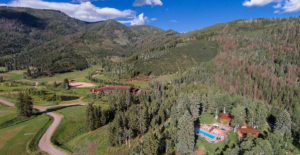Two years ago, 600-acre Peace Ranch near Aspen, Colo., hit the market for $49.5 million. The price tag was later reduced to $39.9 million, but when the ranch still hadn’t found a buyer by the end of the summer, the owner decided to turn to an auction. On November 6th, Peace Ranch is scheduled to be auctioned off to the highest bidder–with no minimum price.
 A Western outdoor-lover’s paradise of trails, stocked fishing ponds, and abundant wildlife, Peace Ranch is fully surrounded by national forest. Since the only access to the forest land is through the ranch (or up a mountain on the far side of those 20,000 acres), the land is supremely private. The property features five residences with a total of 16 bedrooms and 15 baths, and a 35,000-square foot riding arena. “It’s like paradise on Earth,” says owner Tom Bedell.
A Western outdoor-lover’s paradise of trails, stocked fishing ponds, and abundant wildlife, Peace Ranch is fully surrounded by national forest. Since the only access to the forest land is through the ranch (or up a mountain on the far side of those 20,000 acres), the land is supremely private. The property features five residences with a total of 16 bedrooms and 15 baths, and a 35,000-square foot riding arena. “It’s like paradise on Earth,” says owner Tom Bedell.
 So why is he selling? Passions change, and Bedell and his wife Molly are spending more time on their businesses—he an acoustic guitar business in Bend, Ore., she a clothing shop in Nashville, Tenn.—and don’t get to the ranch much. The couple bought it for $12.5 million in 2003, after selling Berkley & Company, the fishing-tackle business Tom’s father founded in 1937. The Bedells poured $30 million in to the ranch, adding roads, reclaiming creeks, building the horse facilities, remodeling and building new housing. After waiting for two years for it to sell, they didn’t want to let the ranch sit on the market through another winter.
So why is he selling? Passions change, and Bedell and his wife Molly are spending more time on their businesses—he an acoustic guitar business in Bend, Ore., she a clothing shop in Nashville, Tenn.—and don’t get to the ranch much. The couple bought it for $12.5 million in 2003, after selling Berkley & Company, the fishing-tackle business Tom’s father founded in 1937. The Bedells poured $30 million in to the ranch, adding roads, reclaiming creeks, building the horse facilities, remodeling and building new housing. After waiting for two years for it to sell, they didn’t want to let the ranch sit on the market through another winter.



As the housing market recovers, more luxury property owners are bringing their homes and ranches to auction, where they can dispose of them more quickly. Properties with multi-million dollar price tags often to take one, two, even three years to sell. “The biggest reason that sellers do an auction is they want to sell in a certain period of time,” says Ed Kaminsky, president of Manhattan Beach, Calif.-based Premiere Estates Auction Company.
The National Auctioneers Association does not have data on the number of auctions that take place in the U.S. each year. However, individual firms say that luxury auctions–which all but dried up in the economic downturn–are back. Before the crash, Kaminsky’s firm auctioned off about 10 to 15 high-end properties per year. “Now we’re doing probably triple what we were doing then,” he says. Daniel DeCaro, president of Naples, Fla.-based DeCaro Luxury Real Estate Auctions, says that between 2003 and 2006, 95% of the properties he marketed for auction sold before the auction even occurred. Then in 2006, the pre-auction sales abruptly stopped. “It was like somebody turned a faucet,” DeCaro says, and “by late 2008 and early 2009, we were seeing the faucet shut off as far as buyers.” The corner turned in late 2011 and early 2012, and now DeCaro is back to selling about 20 properties a year. Gadsen, Ala.-based JP King Auction Company tells a similar story.
Once associated only with distressed properties, auctions gained traction as a way to sell luxury real estate in the late 1990′s and early 2000′s. The uptick in auctions in the past couple of years as the economy recovers may be due in part to some widely publicized luxury sales. New York-based Concierge Auctions (which is auctioning Peace Ranch) has marketed properties of such celebrities as Cher, football stars Kurt Warner and Deion Sanders, and basketball legend Michael Jordan. From 2008 to 2013, Concierge sold more than $500 million in luxury properties, says its president, Laura Brady. This year, Concierge is on track to complete 65 auctions and beat last year’s $194 million sales figure, she says.
Sometimes, an auction can be a way to get a better price. In 2010, Concierge auctioned Cher’s 8,800-square-foot home in the Hualalai resort on Hawaii’s Kona Coast for $8.7 million, $200,000 above the original $8.5 million list price. “This one was a success story,” says Rob Kildow, director of residential sales and principal broker at Hualalai.
But not all auctions result in a better price–or even a sale. After his 11,300-square-foot Contemporary-style home in Paradise Valley, Ariz., sat on the market for two years, former NFL quarterback Kurt Warner auctioned it off with Concierge Auctions. The winning bid was about $2.5 million, half the $5 million list price. Basketball star Michael Jordan fared far worse when he tried to sell his home through a Concierge auction: no bidder hit the $13 million “reserve,” or minimum price, and the home failed to sell. In January, the home returned to the market at $16 million, well below the $29 million price tag it had when it debuted on the market in March 2012.
Concierge tries to avoid such situations, in some cases by delaying auctions repeatedly (Peace Ranch’s auction date has now been pushed back twice), until a sufficient group of bidders is collected. The company also tries to get bidders to show their cards, by offering them a discount on the buyer’s premium–a 10% fee on the sale price that buyers pay to the auction company–if they start their bidding at a particular price. But those incentives don’t lock a buyer in to bidding at that level, and it is unclear how well they work. Ultimately, an absolute auction (where there is no reserve price) is just that: the home will be auctioned off to the highest bidder.
Perhaps the most noted recent example is the Versace Mansion in Miami. Once listed for $125 million, the mansion, also known as Casa Casuarina, was expected to break Miami’s then-record price: $47 million for 3 Indian Creek. Instead, the mansion sold for $41.5 million in a bankruptcy auction in September 2013. The winning bid came from VM South Beach LLC, an investor group that included the Nakash family of Jordache jeans. Donald Trump was the back-up bidder, meaning that he gave the second-to-last bid
